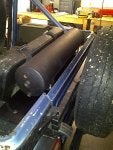got the plugs redone with antisieze and holding air fine it seems.
a problem i ran into when testing is that im not reading anything above 10-15 psi at my manifold which is right near the compressor.
i can relieve the air pressure at the tank fine so i know its getting back there.
after about 20 seconds of running, the output hose on the compressor gets really hot. i removed the hose and put my finger over the output hole while its running and can only hold it there for for that 20 seconds before i have to pull away b/c of heat.
Do you have a 'Whip' on your compressor?
A braided stainless hose on the compressor about 15" or 18" long?
If you don't have, let me know and I'll send you one, I have a couple of extras laying around here, and you MUST have one.
The compressor head gets VERY hot, and will melt the seals out of regular fittings, melt lines shut, ect. when the compressor runs very long.
You may not see the melted lines inside of the fittings, but I will GUARANTEE YOU it will melt most lines!
Some guys run a whip to a hard line, then run a hard (usually aluminum) line to the tank or distribution block.
The idea of aluminum or copper line is to shed heat on the way to the distribution block or tank and cool the air down so you don't melt fittings.
Whips also keep hard lines from fracturing with the vibration of the compressor,
Compressors are vibration machines, and they are VERY HARD on hard line connections to them!
I used a 18" whip and never had any issues with melting lines when the whip was connected to an aluminum distribution block.
I usually put the distribution block at the end of the 'Whip',
The metal of the distribution/manifold block,
Especially brass or aluminum blocks, helps transfer heat out of the compressed air to atmosphere.
Even more so if your distribution block/manifold is mounted directly to metal, which works as a bigger heat sink for you.
A little dielectric grease helps keep moisture from collecting between block and sheet metal, keeping rust to a minimum...
Once the air hits the block, you should have outlets in all directions, forward, backwards, up for use with an air chuck...
Which gauge is giving you the strange readings, and do both gauges agree on tank/system pressure?
The distribution block gauge should be compressor/tank pressure,
The second gauge should show what the regulator is set at.
If you are going by the regulator gauge, then turn the regulator up and see if that changes things...










